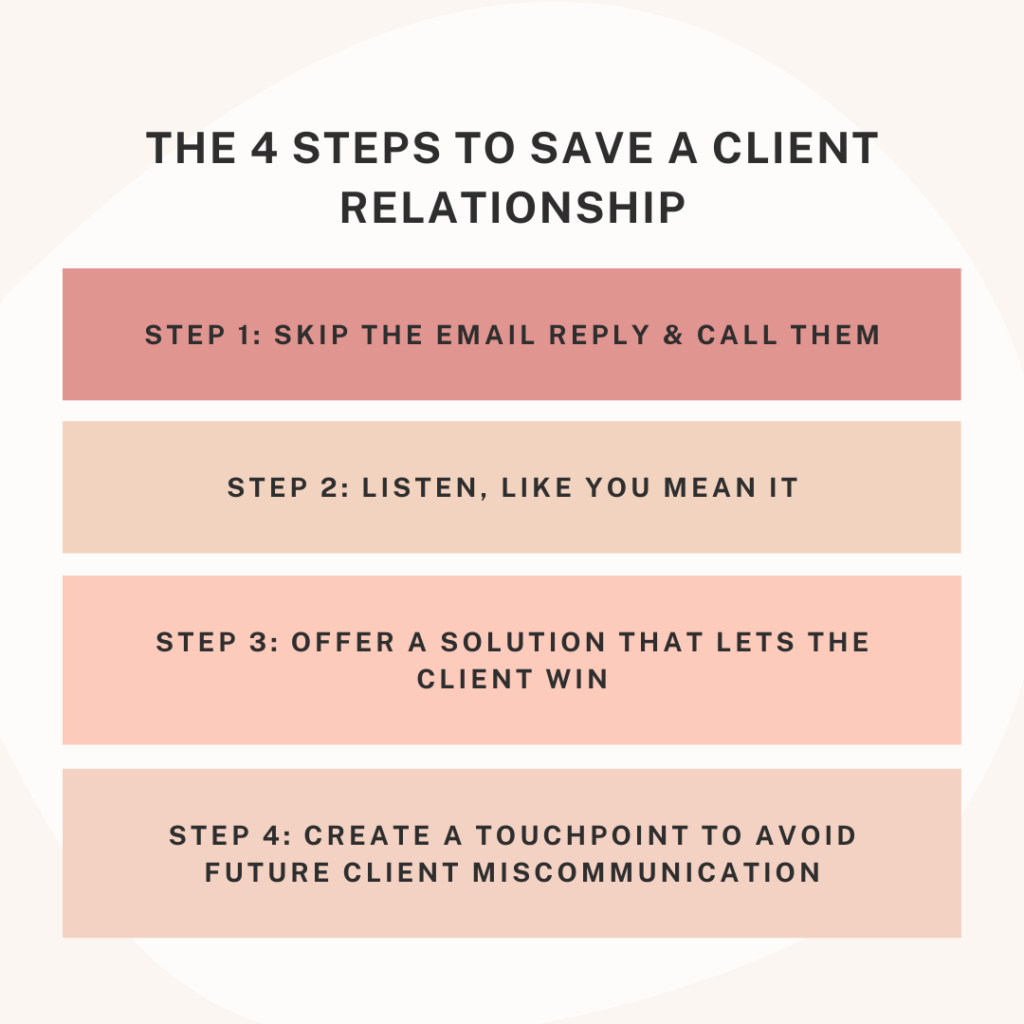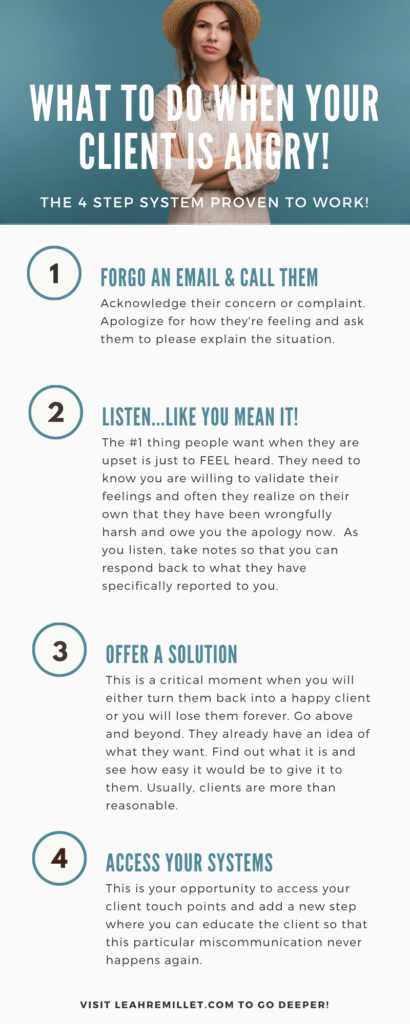Your client is mad.
Which, makes you sad.
Now what?
The day you have your first unhappy client sucks and it’s not easy to forget. You’ve been moving along, working as hard as you can, and you’re sure that how much you care is obviously written across every part of what you do. How could anyone doubt your commitment to your clients? How could anyone doubt your intentions? But there it is, DOUBT. It’s big, it’s mean, and it can stop you dead in your tracks. Your heart pounds, you playback every encounter between you and the client, and you try to swallow your pride and calm your heartbeat back down as you decide what to do.
You wonder…
- How can they be so wrong? Surely this is on them and not me! (But you realize this won’t get you anywhere!)
- Do I write her back and correct her wrong thinking?
- Do I just say nothing and hope it goes away?
- Am I going to have to refund or pay for this and if so can I afford it?
Is it possible to gracefully handle unhappy clients? ABSOLUTELY! There is hope! You are still a great business owner and you now have the potential to not only fix this, but be better because of it!
Here’s a 4-Step System for tuning ‘red-in-the-face’ clients back into happy clients and to be sure you never go through that again!

1. Skip email & go straight to the phone.
It’s staring right at you…an email that has just left you with a pit in the bottom of your stomach. It’s time to take action and you’ll want to do it quickly! The fastest way is the phone. I know the phone can be scary for many, but please trust me on this! Intentions can be misconstrued WAY too easily when emoticons and ‘LOLs’ are your way of conveying emotion. Instead, you’re going to call the client. But first, take some notes so you feel prepared. Write down questions you want to ask for further clarification and touch points for what you want to say. But at the very top of that note in bold capital letters, write, ‘LISTEN’ (more on that in a moment). Last, think about what solutions you’d like to offer and are willing to offer (I always err on the side of my clients’ benefit and not mine). Now that you have a drafted plan in place, it’s time to pick up the phone, take a deep breath, and dial your client.
Start the conversation by acknowledging their concern or complaint. Apologize for how they’re feeling (note that you may not be necessarily apologizing for what happened, but you can always wish they were feeling better about your services) and ask them to please explain the situation. This brings us right into my second tip…
2. Listen.
The #1 thing people want when they are upset (according to research and any woman in a fight with her husband) is just to FEEL heard. So start by letting them talk it ALL out. Your very first item on the agenda for this call is to let them explain to their heart’s content. While you’re letting them talk it all out, make sure to listen REALLY carefully. If they need to talk until they’re blue in the face and it comes with nasty accusations and hurtful words…try to bite your tongue and let the client unload. They need to know you are willing to validate their feelings and often this creates an interesting turn of events where they realize on their own that they have been wrongfully harsh and owe you the apology now. As you listen, take notes so that you can respond back to what they have specifically reported to you.

3. Offer a solution.
This is not the time to skimp. This is a critical moment in your customer’s relationship with you when you will either turn them back into a happy client or you will lose any possibility of a good outcome. Go above and beyond. They already have an idea of what they want in their mind. So find out what it is and see how easy it would be to just do it for them. Most of the time clients are more reasonable than we give them credit for.
If it’s possible to do what they are asking for….DO IT! According to Lee Resources, a customer whose complaint is resolved in their favor will do business with that business again 70% of the time. It’s better to take a loss and remedy the problem than to have that negativity floating around. Even better is when you’re able to take that unhappy client and show so much customer service and devotion, that they become a happy client again.
Bottom line, if you take the side of believing that you need to protect you, you’re not only going to fail but you missed the bigger picture. By not taking care of them, you’ve opened yourself up for further attacks because you can be sure they’re going to talk about you to their friends. Your “win” will become a loss.
4. Access your systems.
The one thing you’ll know with complete certainty after the conflict is said and done is that you never want to go through that again! But will you do anything to ensure you won’t have to?
This is your opportunity to access your client touch points and systems and add a new step where you can educate the client so that this particular miscommunication never happens again. This could be a piece of literature or a checkpoint that you discuss in an on-boarding call, or maybe there’s another way to ensure expectations are clear.
Disgruntled clients are the outcome of unclear expectations – that means somewhere along the line they were under one assumption and you, another. What can you do to make sure expectations are clear to the next customer? As soon as you identify the step, plug it into your process.

WARNING: I feel like there is a caveat that I must include. Sometimes people are impossible to please (when this happens, typically you’re not even the real problem. Something on their end is the culprit). In these situations, you can’t win. That means the only option is to cut your losses and walk away. While I want to acknowledge that these types of people are out there, I truly believe that they are the exception. For the vast majority, disgruntled clients are the outcome of unclear expectations and in that case, the best thing we can do is listen, offer a remedy, repair, and then build a new step in our client process so the confusion loop is closed. I would never want to suggest being taken advantage of, but often what I see is business owners so stuck on themselves and their prerogative that they leave a truly hopeful client with no good will to hold on to.
So the key to remedying an unhappy client is truly simple; respond back as quickly as possible (time allows festering), listen intently, offer a better than expected solution, and finally, check what systems you can implement to make sure that you never have to go through this again.
I think Gary Vaynerchuck sums it up perfectly; “It’s very logical: There is proven ROI in doing whatever you can to turn your customers into advocates for your brand or business. The way to create advocates is to offer superior customer service.”

you said: